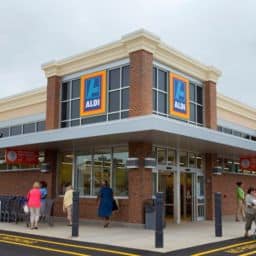Deciphering the Economic Downturn
Gavin P. Smith – Griffin Report
It has been a rocky time in the markets, both in the U.S. and around the globe. No industry can escape the affects of the current credit freeze and financial failures. The climate is dicey, and major industry leaders are taking bold adaptive measures to head off what may be a pending global recession.
New research by Nielsen shows 85 percent of U.S. consumers believe the country is in a recession and almost 70 percent of them believe the next 12 months are either a “bad” or “not so good” time to buy things they want or need. This has a major impact on supermarket, food service, c-store and petroleum verticals.
Supermarkets
In the supermarket sector, expansion plans continue but have been reigned in to more conservative projections, due to the economic climate. Many report that higher commodity costs have had a fairly significant effect on the retail cost of groceries in stores. Much of this commodity cost increase can be attributed to higher fuel costs during the third quarter.
In order to retain customers and maintain revenue growth, many supermarkets are getting creative in their deployment of so-called ‘loyalty builders’, programs designed to encourage customer retention. The presentation of meal solutions was the most frequent choice of both retailers (26.1%) and manufacturers (38.1%) when they were asked about the services that can best build loyalty in Center Store. The response was followed by loyalty clubs/targeted offers, which were chosen by 24.6% of retailers and 23.8% of manufacturers, and in-store cooking demonstrations/recipe distribution, which were chosen by 17.4% of retailers and 14.3% of manufacturers.
These details only provide a broad snapshot. With a brief drilldown into the supermarket sector, we’ll take a look at a few key players.
- Kroger
While many supermarkets are feeling the credit crunch and economic pinch, Kroger remains confident, touting well-placed credit and financials despite the downturn.
“In this uncertain economy, we are delivering value to shoppers on any budget through our Customer 1st approach,” said David B. Dillon, Kroger chairman and chief executive officer. “Our financial strategy provides us with sufficient liquidity to finance our short-term borrowing needs through our $2.5 billion five-year credit facility that matures in November 2011. On peak borrowing days, we expect that more than $1.2 billion of this facility would remain available. In addition, Kroger maintains uncommitted money market lines totaling $75 million.”
Based on Kroger’s year-to-date results and management’s outlook for the remainder of the fiscal year, the Company reaffirmed that it expects identical supermarket sales growth of 4.5% to 5.5%, excluding fuel, for fiscal 2008.
- Whole Foods
Whole Foods derives high confidence spurned from a continued level of demand in the market for natural and organic products, providing an edge over traditional supermarkets. However, they offer a more realistic and telling report of what the current economic crisis has posed to their bottom line as well as future financial operations.
“Our business model has been highly successful, and we remain very bullish on our growth prospects as the market for natural and organic products continues to grow and as our company continues to evolve; however, the challenging economic environment appears to be negatively impacting our sales,” said John Mackey, chairman, chief executive officer, and co-founder of Whole Foods Market. “This, combined with our commitment to maintaining financial flexibility and investing prudently in our long-term growth, has led us to take a more conservative approach to our growth and business strategy over the short term.”
Just how conservative? Whole Foods plans to reduce their expansion to just 15 stores in 2009. In addition, all discretionary capital expenditure budgets not related to new stores have been slashed by a whopping 50%. The company has already implemented certain cost containment measures for the remainder of FY08 and is completely suspending quarterly cash dividends indefinitely.
“We have not undertaken any of these difficult decisions lightly,” said Mackey. “We are committed to improving our financial results and believe these proactive steps are necessary to manage through the current challenging environment, enabling us to emerge stronger and better positioned to realize our growth potential and fulfill our long-term mission and core values.”
- Aldi
While larger chains are experiencing a new sense of conservatism, upstart Aldi remains on their growth track.
“Aldi is proud to offer shoppers prices up to 50 percent lower than traditional supermarkets on high quality fresh produce, fresh meats and grocery items and we’ll continue to provide the lowest market price available,” said Martha Swaney, Public Relations for Aldi. “With shoppers feeling the pinch of rising food price inflation, Aldi offers a smart alternative: significant savings without compromising great taste and quality.”
Aldi is experiencing significant growth this year despite economic conditions. This includes 100 new stores in 2008, double the typical rate of expansion. This also includes two new markets (Rhode Island and Central Florida. According to Swaney, customer loyalty and retention continues to play a big part in their weathering of the economic storm.
“While we’re proud to have some of the most loyal customers in the industry, but at the same time, certainly more people are finding out about us,” said Swaney. “As evidenced by our growth, once shoppers try Aldi, they keep coming back.”
- Walmart – The Oracle of Middle Class Economic Power
Many Walmart Supercenters involve the supermarket component, and given that Walmart has been a barometer for the broad spectrum of economic health, their numbers and plans are worth scrutiny. They may also be the best indicator of what lies ahead for all of the industries in our report.
“We are operating from a position of strength, with the strategy of moderating store growth and increasing operating cash flow,” said Tom Schoewe, Executive Vice President and Chief Financial Officer. “This provides significant free cash flow to invest in our business, while delivering returns to our shareholders through dividends and share repurchases.”
While Schoewe expresses bold confidence, a chart of Walmart capital expenditures may be more revealing. The numbers show reduced projections for FY09 and FY10 for Walmart U.S. growth expenditures. In FY09, they project only $5.8-6.4b and in FY10, they project only $6.3-6.8b. Both numbers are down substantially from the actual $9.1b spent in FY08.
Also, in Walmart’s “Additional Square Footage Detail for Growth” chart, while projecting continued positive growth, the trend does show a slow-down. Walmart U.S. added 26m square feet in FY08, and plans to add 23m square feet in FY09. However, by FY10, they expect to slow expansion (by almost 54% compared to FY08) to only 14m square feet. The climate overseas may be a bit more stable, as revealed in plans to continue international store square footage expansion at consistent levels of increase through 2010.
In the United States, Walmart will continue to focus on supercenter growth.
“Supercenters continue to have the highest rate of return of our U.S. formats,” Schoewe said. “We have designed new supercenter formats that occupy less square footage and incorporate sustainable building practices that make them more efficient.”
Food Service (Fast Food and Restaurant)
In this vertical, the economy has perhaps the most direct impact on the consumer. According to a recent Zagat survey for New York City, the number of restaurant openings declined for the first time since 2003 (from 163 to 119). As well, diners are downsizing their restaurant-going by eating in less expensive places (38%), being more attentive to menu prices (35%), skipping appetizers or desserts (21%) and cutting back on alcohol consumption (19%). At the same time, the demise of financial institutions such as Bear Stearns and Lehman and general belt tightening by many other companies are cutting into year-end party giving.
“Restaurants are clearly feeling the pinch from the economic crisis,” said Tim Zagat, CEO of Zagat Survey. “But in the long run they will weather this storm.”
Consumer spending power is clearly reducing, and the latent affect may be extra growth in fast-food. Standard-bearer for fast-food, McDonald’s Corporation continues to flourish.
“Our unwavering commitment to providing an outstanding restaurant experience to every customer, every time is driving comparable sales momentum and profitability growth in each area of the world,” said Jim Skinner, CEO.
McDonald’s is dominating due, in part, to their global reach. In the third quarter alone, their global comparable sales increased 7.1%. Consolidated operating income increased 20% overall, with earnings per share from continuing operations up 27% from last year. To punctuate this success, McDonald’s has increased their quarterly cash dividends by a substantial 33% to $0.50 per share – the equivalent of $2.00 per share annually – and the company repurchased $1b of its own stock.
“Disciplined financial practices are the foundation of our enduring performance and provide critical support to our strategies,” said Skinner. “McDonald’s is a strong, stable global business and remains well positioned to generate long-term profitable growth for our system and our shareholders.”
C-Stores
Zeroing in on regional business, C-Stores are also feeling the constraints of a potential recession in place.
Initially, the news was grim. Skyrocketing prices in the channel’s highest revenue category, motor fuel, caused a reduction in gallons sold, inflating the price of almost everything else sold inside the store, and compelling customers to pay more with plastic, contributing to a meteoric rise in credit card transaction expenses.
With doom-and-gloom forecasts predicting that gas would continue to skyrocket into late 2009, many c-stores scrambled to figure out how to keep in-store food and product sales from evaporating. Many have looked to bundling, adding fast-food outlets to their stations from the likes of McDonald’s, Subway, Quiznos, Wendy’s and others, creating a symbiotic relationship to garner more c-store traffic.
Fortunately, with crude oil prices falling rapidly, prices at the pump are also taking a freefall, encouraging consumer demand to return to the pumps and the stores once again. However, c-stores aren’t quite off the hook regarding fiscal constraints.
Sanford, NC-based convenience store chain The Pantry, Inc. (including its flagship banner Kangaroo Express), remains one of the larger chains in the country, with FY07 revenues of $6.9b. With almost 1,700 stores in eleven states, indicators in their financials should tell the story for c-stores in general.
For the first nine months of fiscal 2008, total revenues were approximately $6.5 billion, a 32.5% increase from the corresponding period a year ago. However, net income was down over 50% for the nine-month period, registering at $8.8 million, or $0.40 per share, compared with $21.1 million, or $0.92 per share, a year ago.
“Operating conditions remained challenging in the third quarter, with a series of new record highs for crude oil prices and a continued soft retail environment,” said Peter J. Sodini, Chairman and Chief Executive Officer. “Our results benefited from our continued focus on maximizing gasoline gross profits and on expense management.”
With the economic impact, especially related to crude oil prices, The Pantry has had to take some hard fiscal measures to stave off the need for any credit infusions in the short-term.
“With our suspension of acquisition activity and share repurchases for at least the balance of the calendar year, and our substantial reduction in non-essential capital expenditures, we continue to expect that we will generate free cash flows in the months ahead, even if there is no significant change in the current macroeconomic environment,” said Sodini.
As of June, the Company had approximately $162 million of cash and short-term investments, with an additional $142 million available under its revolving credit facility.
The Bottom Line
While this study has only put a handful of industry players under the microscope, it does show that the economic turmoil taking place on Wall Street is also trickling down to supermarkets and distribution, food services, convenience stores, and other retailers on Main Street. However, as this examination shows, all companies are taking the proactive approach, switching to conservative and measured financial plans. As all verticals brace for fourth quarter reports, all watch and wait to see whether the markets intend to stabilize, or slide into recession globally.



